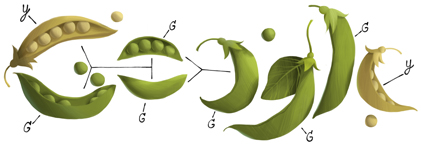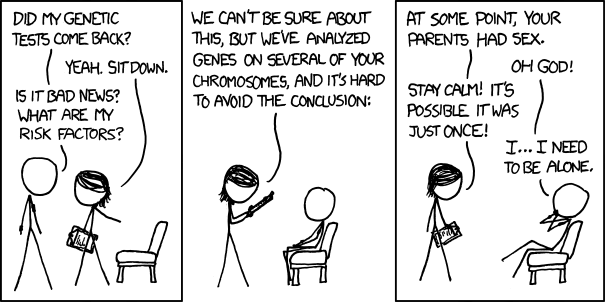From a top donor:
“I’d like you to write a blog entry (primer) about neutral theory aimed at the layperson.”
Okay, I’m not going to lie. I’ve been secretly hoping someone would bump this question out of the top ten, mainly because neutral theory is kind of boring and vaguely confusing and hard enough to explain while using biology buzzwords. It’s even harder to explain when you only have 30 minutes to write about it and it’s supposed to be targeting non-biologists. When I shared this question with some fellow genetics grad students, the general response was “Ewwwww.”
But I will try my best!
When most people think about evolution, they think of adaptations. Something in the environment puts selective pressure on a certain trait, and organisms with that trait are more “fit” (reproduce more). For example, rabbits that live in snowy climates are more likely to survive (and reproduce) if they have white fur that helps them blend into the snow. If a mutation randomly arises that make their fur white, or just lighter, that rabbit has an advantage over the other rabbits – the dark brown ones are going to be the first ones that are eaten.
There are lots of examples of adaptive evolution through natural selection, and people know them more because they make good stories. The most famous example of evolution, Darwin’s finches, is a case of adaptive evolution.
But not all evolution takes place because of natural selection. Evolution is at its simplest defined as the change in allele frequencies over time. That’s where neutral theory comes in. Neutral theory states that most evolutionary changes are the result of random drift of neutral mutants.
Buzzwords buzzwords, I know. So let’s take it one step at a time and pretend that we’re looking at a population of unicorns (if we’re pretending, might as well pretend all the way).
Alleles are just two different forms of a gene. Genes are usually hundreds or thousands of basepairs long, but let’s pretend we’re zooming in on three bases in a gene for fur color. If you have the sequence AAA, your fur is white. But if you have AAG, your fur is pink. AAA and AAG are different alleles.
Now let’s say all of the unicorns start as AAA, and then from mutation you get a unicorn who’s AAG. Being pink has no effect on the unicorn. He’s not more likely to get eaten, he doesn’t live longer, he doesn’t have more luck with lady unicorns. It’s a “neutral” mutation because it doesn’t change the unicorn’s fitness.
That’s where random drift comes in. Drift simply refers to the frequency of one allele changing due to random chance. That is, nothing is selecting for pinkness. Maybe that unicorn just happened to have more offspring. Maybe the population underwent a bottleneck and was reduced to just a few unicorns, the pink one happened to survive, and now his pinkness will make up a larger percentage of the population. Maybe a couple of unicorns, including the pink one, happened to get isolated on one side of a river, so that side eventually had a lot of pink unicorns, while the other has a lot of white ones. Through random chance alone, a neutral mutation can grow to high frequency or even reach 100% (what biologists call “becoming fixed in a population.”)
When you get into the mathematics, you assume that random neutral mutations occur at the same rates across individuals. This is how biologists get things like “molecular clocks” where they can tell when two species diverged from each other.
…And I have no idea if that made any sense, but I’m out of time. You have all now been exposed to (a shoddy summary of) evolutionary theory, congratulations. If anyone would like to explain further or correct me in the comments, please do so!
This is post 20 of 49 of Blogathon. Pledge a donation to the Secular Student Alliance here.


